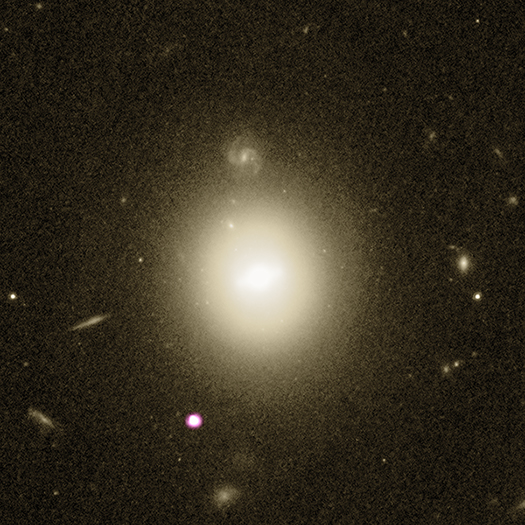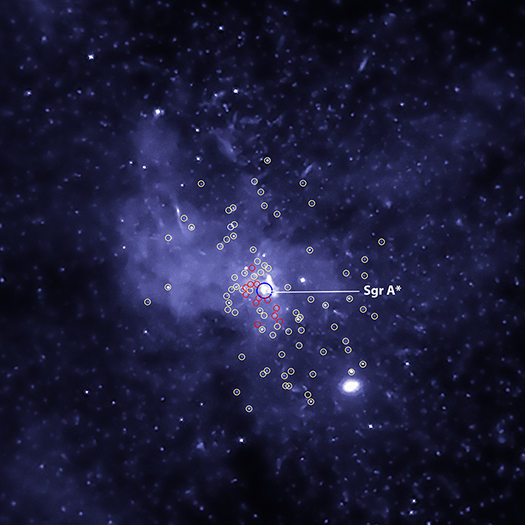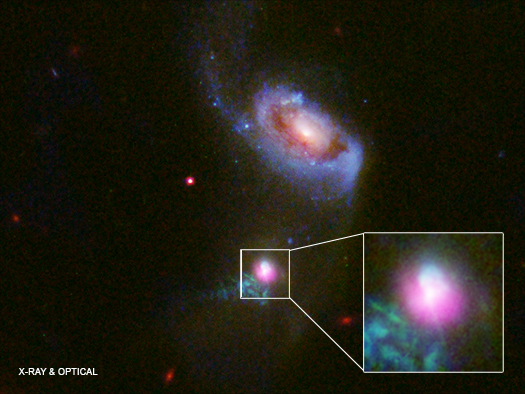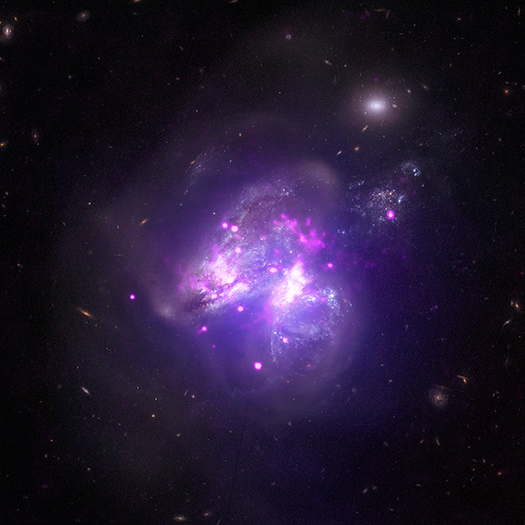Black Holes
Star Shredded by Rare Breed of Black Hole
Submitted by chandra on Mon, 2018-06-18 13:17A team of researchers using data from ESA's XMM-Newton X-ray space observatory, NASA's Chandra X-ray Observatory and NASA's Swift X-Ray Telescope has found evidence for the existence of an intermediate-mass black hole (IMBH).
Scientists have strong evidence for the existence of stellar black holes, which are typically five to 30 times as massive as the Sun. They have also discovered that supermassive black holes with masses as large as billions of Suns exist in the centers of most galaxies. They have long been searching for IMBHs that would exist in between these two extremes, which would contain thousands of solar masses. Thought to be seeds that will eventually grow to become supermassive, IMBHs are especially elusive, and thus very few robust candidates have ever been found.
Two Neutron Stars + Gravitational Waves = A Black Hole
Submitted by chandra on Thu, 2018-05-31 10:42
Dave Pooley
It is a pleasure to welcome Dave Pooley as a guest blogger. Dave led the black hole study that is the subject of our latest press release. He is an associate professor at Trinity University in San Antonio, Texas, where he loves doing research with a cadre of amazing undergraduates on topics ranging from gravitational lensing to supermassive black holes to supernova explosions to exotic X-ray binaries to globular clusters. He lives in Austin with his wife, two (soon to be three) children, two cats, and one dog. When he’s not setting up train tracks, watching Daniel Tiger, or analyzing Chandra data, he enjoys cooking, woodworking, and all manner of whisky.
A colleague of mine at MIT once said that the minute the Laser Interferometer Gravitational Wave Observatory (LIGO) detects gravitational waves, it will be one of the most successful physics experiments ever performed, and the next minute, it will immediately become one of the most successful astronomical observatories ever operated.
He was exactly right. The direct detection of gravitational waves was a tremendous success for fundamental physics. We knew that gravitational radiation existed, but to directly detect it was huge. It was a triumph due to the meticulous and brilliant work of the hundreds of people who worked for years and years to make LIGO a success.
And immediately with that first detection, astronomers added gravitational waves to our tool belt of ways to study the universe. With just that first event, which was a merger of two black holes, we learned so much more about black holes than we previously knew. That, in turn, raised even more questions about these intriguing objects. Clearly, 60-solar-mass black holes exist. (That was news to us!) And you make them from 30-solar-mass black holes. (That was news to us too!) So 30-solar-mass black holes exist. (Even that was news to us, too!) But how do you make those? We astronomers have a few ideas, but we’re really not sure. We haven’t figured that out yet. Nature of course, already has.
Sagittarius A* Swarm: Black Hole Bounty Captured in the Milky Way Center
Submitted by chandra on Wed, 2018-05-09 10:05Astronomers have discovered evidence for thousands of black holes located near the center of our Milky Way galaxy using data from NASA's Chandra X-ray Observatory.
This black hole bounty consists of stellar-mass black holes, which typically weigh between five to 30 times the mass of the Sun. These newly identified black holes were found within three light years — a relatively short distance on cosmic scales — of the supermassive black hole at our Galaxy's center known as Sagittarius A* (Sgr A*).
Theoretical studies of the dynamics of stars in galaxies have indicated that a large population of stellar mass black holes — as many as 20,000 — could drift inward over the eons and collect around Sgr A*. This recent analysis using Chandra data is the first observational evidence for such a black hole bounty.
A black hole by itself is invisible. However, a black hole — or neutron star — locked in close orbit with a star will pull gas from its companion (astronomers call these systems "X-ray binaries"). This material falls into a disk and heats up to millions of degrees and produces X-rays before disappearing into the black hole. Some of these X-ray binaries appear as point-like sources in the Chandra image.
The Billion-year Race Between Black Holes and Galaxies: Mar Mezcua
Submitted by chandra on Wed, 2018-02-14 13:30
Mar Mezcua
Mar Mezcua is a postdoctoral researcher at the Institute of Space Sciences, in Barcelona (Spain), where she is from. She is a guest blogger today and the leading author of one of the two papers highlighted in our latest press release. aShe conducted this work last year with Prof. Julie Hlavacek Larrondo while at the University of Montreal (Canada).
Supermassive black holes (SMBHs) started to fascinate me when I was 13 years old. These monsters reside at the center of massive galaxies and are the most energetic sources in the Universe. When they are actively accreting, the surrounding matter that feeds them (or that the black hole accretes) can radiate over a trillion times as much energy as the Sun, being able even to outshine the galaxy in which they reside. This feeding, or accreted, material emits X-ray radiation that we can detect with X-ray satellites such as Chandra, while the material that is ejected from the SMBH in the form of jets also often emit at radio wavelengths. (Yes, SMBHs do not only swallow but also emit outflows of energetic particles!) It is for all the above that I pursued a career in astrophysics in order to study these powerful behemoths in detail.
My first close approach took place during my PhD, when I estimated the black holes (BH) masses of a sample of SMBHs whose radio jets had a peculiar morphology. To do this, I used the close relationships that had been recently found between the mass of SMBHs and some of their host galaxy properties, such as how much light was emitted by the central bulge or how quickly and where the stars in the bulge moved.
The finding of such correlations suggested that SMBHs and their host galaxies grow in tandem — that there is a co-evolution — implying that SMBHs somehow regulate the growth of the galaxy in which they reside. As simple as it might sound, this was an astonishing discovery of the late 90’s. SMBHs typically have masses of between one million and one billion times that of the Sun and sizes similar to that of the Solar System, this is, nearly 10,000 times smaller than the galaxy that hosts them. That’s a huge difference in size! How is it then possible that such a ‘small’ central SMBH controls the whole budget of a galaxy? SMBHs were getting more and more exciting every time, so after my PhD I kept on studying them using all tools I had available: radio, optical, infrared and X-ray observations!
The Billion-year Race Between Black Holes and Galaxies: Guang Yang
Submitted by chandra on Wed, 2018-02-14 13:13
Guang Yang
We welcome Guang Yang, a 4th-year Astronomy graduate student at Penn State, as a guest blogger. Guang led one of the two studies reported in our new press release about the evolution of supermassive black holes and galaxies. Before studying at Penn State, he obtained his astronomy B.S. degree at the University of Science and Technology of China.
Supermassive black holes, with masses over million times that of our sun, sit in the centers of galaxies. The evolution of these black holes and their host galaxies in the past billions of years of cosmic history is still an unsolved mystery. A prevailing idea is that black hole growth is synchronized with host-galaxy growth, i.e., the ratio between black hole and galaxy growth is constant. "What a beautiful theory," I told my advisor Prof. Niel Brandt, and colleagues Dr. Chien-Ting Chen and Dr. Fabio Vito. "But is it true?” I asked. “Has someone proved it?"
We searched large amounts of literature but did not find dedicated works proving the idea, although it is widely quoted in published papers. "Then why not prove it with observations?" said my advisor. "It can be a great thesis topic for you." I was so happy that my thesis topic was settled and I even dreamed about how our data might nicely support the theory.
We painstakingly analyzed a large amount of data in the Chandra Deep Field-South & North and COSMOS surveys. We successfully tracked the black hole and galaxy growth in the distant universe with NASA's Chandra, Hubble, Spitzer, and other observatories. The observations are so deep that we can study the evolution of black holes and their host galaxies 12 billion years in the past, when the Universe was less than 15% of its current age.
Chandra Helps Track Stormy Weather Around Black Holes
Submitted by chandra on Tue, 2018-01-23 14:08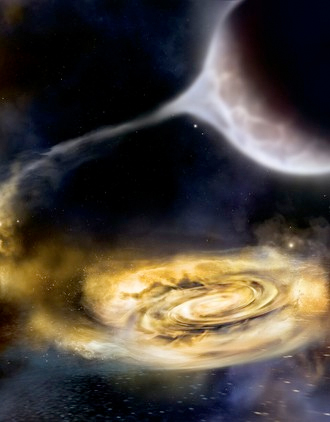
Illustration: NASA/Swift/A. Simonnet, Sonoma State Univ.
An international collaboration of scientists, using data from Chandra and other X-ray telescopes over two decades, has shown that the “weather” around some black holes is stormier than previously thought.
The research, which appears in the January 22th issue of the journal Nature and is available on the arXiv, looked at 21 outbursts in X-rays from 12 X-ray binaries, that is, systems where a stellar-mass black hole is in close orbit with a companion star.
Researchers Catch Supermassive Black Hole Burping — Twice
Submitted by chandra on Thu, 2018-01-11 16:28Using data from several telescopes including NASA's Chandra X-ray Observatory, astronomers have caught a supermassive black hole snacking on gas and then "burping" — not once but twice, as described in our latest press release.
This graphic shows the galaxy, called SDSS J1354+1327 (J1354 for short) in a composite image with data from Chandra (purple), and the Hubble Space Telescope (HST; red, green and blue). The inset box contains a close-up view of the central region around J1354's supermassive black hole. A companion galaxy to J1354 is shown to the north. Researchers also used data from the W.M. Keck Observatory atop Mauna Kea, Hawaii and the Apache Point Observatory (APO) in New Mexico for this finding.
Chandra detected a bright, point-like source of X-ray emission from J1354, a telltale sign of the presence of a supermassive black hole millions or billions of times more massive than our sun. The X-rays are produced by gas heated to millions of degrees by the enormous gravitational and magnetic forces near the black hole. Some of this gas will fall into the black hole, while a portion will be expelled in a powerful outflow of high-energy particles.
A Scuba Dive, a (Failed) Ziploc Bag, and a Trip to the Center of the Galaxy
Submitted by chandra on Wed, 2018-01-10 10:02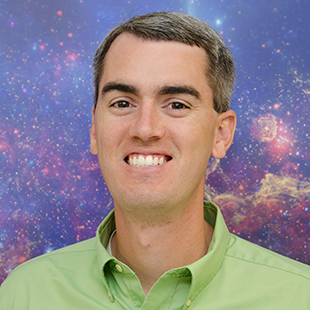
Chris Russell
We welcome this guest post from Christopher Russell of the Pontifical Catholic University in Chile. Dr. Russell was the creator of the new immersive movies that allow viewers to explore the center of the Milky Way in 360 degrees. In this post, Dr. Russell provides the backstory of how he came to make these innovative movies.
I went to a Galactic Center meeting in Australia in July 2016, where I saw an Occulus Rift (a high-end virtual reality, or VR, setup) display by Chi-Kwan Chan (Univ. of Arizona). With the Rift, you plug it into your computer (so much more powerful rendering than available with a phone) and your position actually determines what is rendered. So if you walk left, right, forward, or backward, you are actually walking through the simulation and therefore seeing a different perspective. The thought of visualizing one of these Galactic Center simulations in this fashion was immediately apparent. Then we talked about 360/VR videos; what is required from the goggle side, computer specs, rendering programs, etc.
The day after the meeting, I went snorkeling, and unfortunately the Ziploc bag I put my phone in to keep it waterproof failed. Not one of my brightest ideas, I must say. But when I was looking for a new phone, the one I wanted (Galaxy s7) had two available promotions: get a free 256 GB memory card (useful, but not really fun), or the Samsung Gear VR goggles (definitely fun). I chose the latter, so now I could at least view 360-degree videos in their native format, and so would be able to view one of the Galactic Center if I could figure out how to make it.
Arp 299: Galactic Goulash
Submitted by chandra on Mon, 2017-06-26 15:45What would happen if you took two galaxies and mixed them together over millions of years? A new image including data from NASA's X-ray Observatory reveals the cosmic culinary outcome.
Arp 299 is a system located about 140 million light years from Earth. It contains two galaxies that are merging, creating a partially blended mix of stars from each galaxy in the process.
However, this stellar mix is not the only ingredient. New data from Chandra reveals 25 bright X-ray sources sprinkled throughout the Arp 299 concoction. Fourteen of these sources are such strong emitters of X-rays that astronomers categorize them as "ultra-luminous X-ray sources," or ULXs.
These ULXs are found embedded in regions where stars are currently forming at a rapid rate. Most likely, the ULXs are binary systems where a neutron star or black hole is pulling matter away from a companion star that is much more massive than the Sun. These double star systems are called high-mass X-ray binaries.
Pages
Please note this is a moderated blog. No pornography, spam, profanity or discriminatory remarks are allowed. No personal attacks are allowed. Users should stay on topic to keep it relevant for the readers.
Read the privacy statement


